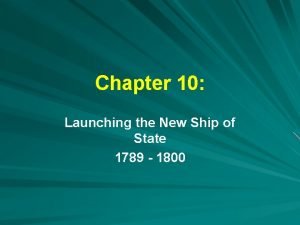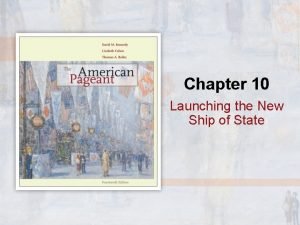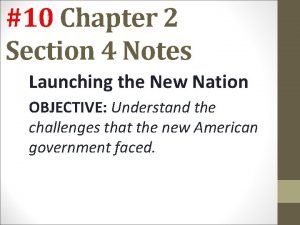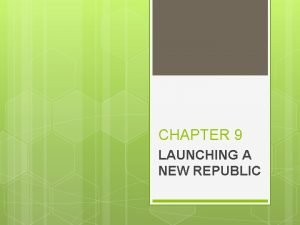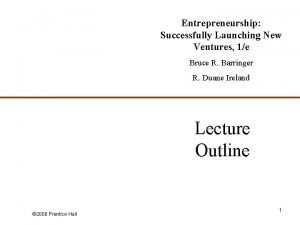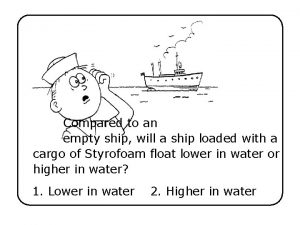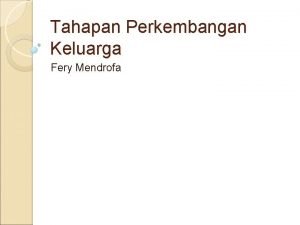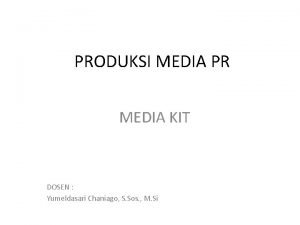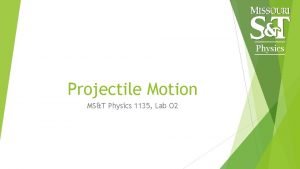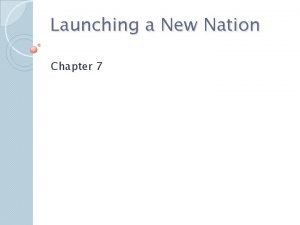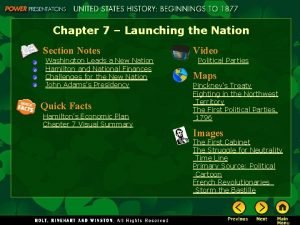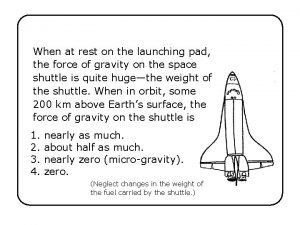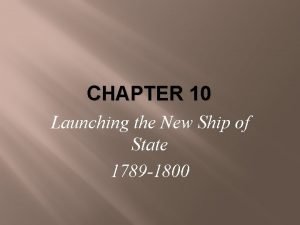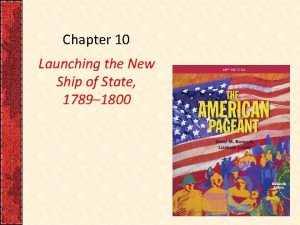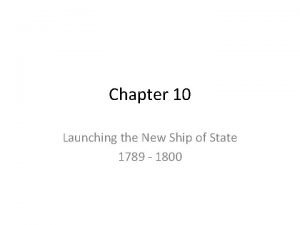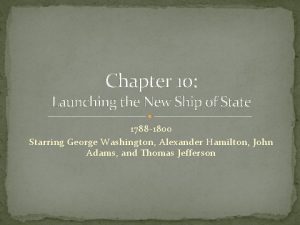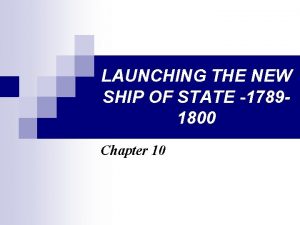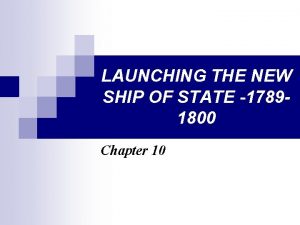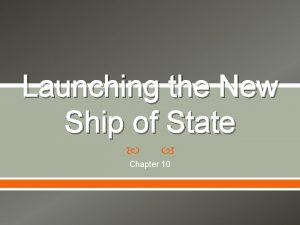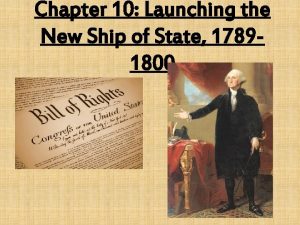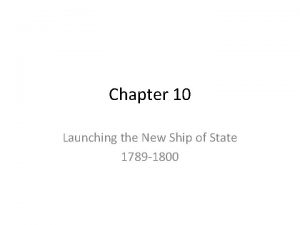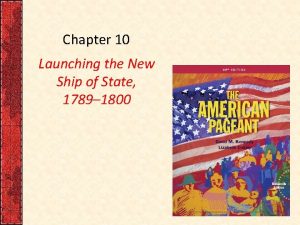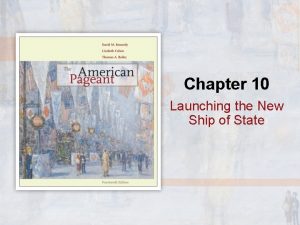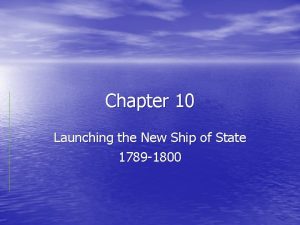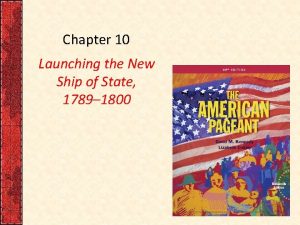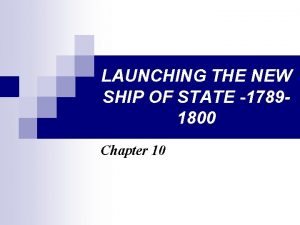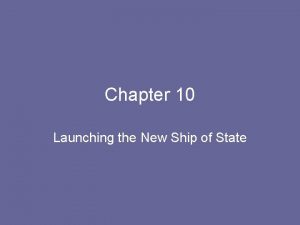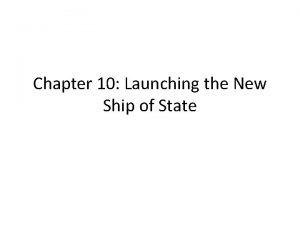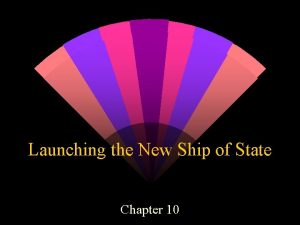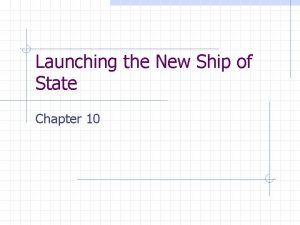Chapter 10 Launching the New Ship of State

























- Slides: 25

Chapter 10 Launching the New Ship of State (1789 -1800)

Chronology 1789 Constitution formally put into effect. Judiciary Act of 1789. Washington elected president. French Revolution begins. Declaration of the Rights of Man (French). 1792 Washington reelected president 1790 First official census. 17921793 Federalist and Democratic. Republican parties formed. 1791 Bill of Rights adopted. Vermont becomes fourteenth state. Banks of the United States created. Excise tax passed. 1793 Louis XVI beheaded; radical phase of French Revolution. Washington’s Neutrality Proclamation. Citizen Genet affair.

Chronology Cont. 1794 Whiskey Rebellion. Battle of Fallen Timbers. Jay’s Treaty with Britain. 1795 Treaty of Greenville; Indians cede Ohio. Pinckney’s Treaty with Spain. 1796 Washington’s Farewell Address 1797 Adams becomes president. XYZ Affair. 1798 Alien and Sedition Acts. 1798 -1799 Virginia and Kentucky resolutions. 1798 -1800 Undeclared war with France. 1800 Convention of 1800: peace with France.

America’s New Ship • America had thrown out Great Britain and the Articles of Confederation in the years following the Revolution • Thought of central government as a necessary evil- something distrusted, watched, and curbed • Revenue was small, but public debt was huge – Worthless paper money – National security threatened by wars in Europe (French Revolution)

I. Growing Pains • 1789: Population was doubling every twentyfive years • 1790: First official census counted 4 million people • Cities were flourishing – Philadelphia: 42, 000 – New York: 33, 000 – Boston: 18, 000 – Charleston: 16, 000 – Baltimore: 13, 000

I. Growing Pains Cont. • Population 90% rural • 95% lived east of the Appalachians • Trans-Appalachian population concentrated in Kentucky, Tennessee, and Ohio (all added as states within 14 years) • Vermont became the 14 th state in 1791 • Pioneer life thought rough and crude to foreign visitors

II. Washington for President • General George Washington unanimously voted president by the Electoral College in 1789 – Only president ever to get a unanimous vote – Commanded his followers by strength of character, not political prowess • Received a triumphant welcome to New York City, the temporary capital • Took the oath of office on April 30, 1789 on a balcony overlooking Wall Street

II. Washington for President Cont. • Washington established a cabinet – Not mentioned in the Constitution, but loosely allowed in the rules for the executive branch – Secretary of State: Thomas Jefferson – Secretary of the Treasury: Alexander Hamilton – Secretary of War: Henry Knox

III. The Bill of Rights • Most states only adopted the Constitution with the promise of the addition of a Bill of Rights • James Madison drafted a list of amendments and submitted them to Congress – Ratified by the necessary number of states in 1791 – Safeguard some of the most precious American principles • Freedom of religion, speech, press; the right to bear and to be tried by jury; and right to assemble and petition the government to redress grievances

III. The Bill of Rights Cont. • Prohibits cruel and unusual punishment and arbitrary seizure of private property • Ninth Amendment: – Certain rights “shall not be construed to deny or disparage others retained by the people. ” • For states’ righters, the Tenth Amendment: – Reserves all rights not explicitly delegated or prohibited by the federal Constitution, “to the States respectively, or to the people. ” • Preserved a strong central government and specified protections for minority and individual liberties.

III. The Bill of Rights Cont. • Judiciary Act of 1789: Organized the Supreme Court with a chief justice and five associates – Federal district and circuit courts – Established the office of the Attorney General • John Jay was the first chief justice of the United States

IV. Hamilton Revives the Corpse of Public Credit • Alexander Hamilton was a key figure in the new government. – Originally from the British West Indies • Loyalty and character questioned – Regarded himself as a sort of prime minister to Washington’s cabinet – Got involved in other departments, including those of Thomas Jefferson, his archrival

IV. Hamilton Revives the Corpse of Public Credit Cont. • Was a financial wizard and was looking to fix the economic frustrations that had crippled the Articles of Confederation – Planned to shape fiscal policies to favor the wealthier groups, who in turn would gratefully lend the government monetary and political support • New federal regime would thrive • Propertied classes would fatten • Prosperity would trickle down to the masses

IV. Hamilton Revives the Corpse of Public Credit Cont. • First objective was to bolster the national credit • Urged Congress to “fund” the entire national debt “at par” ($54 million) and to assume completely the debts incurred by the states during the war • Government bonds had dropped to ten or fifteen cents on the dollar – Speculators bought fistfuls of them

IV. Hamilton Revives the Corpse of Public Credit Cont. • Also urged Congress to pay off the states’ debts of $21. 5 million • Assumption: States were a national obligation because the debts had been incurred during war for independence – Would unify the states and chain them more tightly to the “federal chariot” • Attach wealthy creditors from the states to the federal government – Support of the rich was crucial

IV. Hamilton Revives the Corpse of Public Credit Cont. • States with heavy debt, like Massachusetts were overjoyed by Hamilton’s proposal • Those with smaller debts, like Virginia, were less charmed – Didn’t want the Congress to take on states’ debts, but did want the forthcoming federal district to be located on the Potomac River – Hamilton persuaded Thomas Jefferson to line up enough votes • Carried through in 1790

V. Customs Duties and Excise Taxes • Combining federal and state debts, the national debt was $75 million • Hamilton (“Father of the National Debt”) believed that a national debt was a national blessing to glue the states together • Hamilton believed they could pay the debt with custom duties derived from a tariff – Foreign trade

V. Customs Duties and Excise Taxes Cont. • 1789: First tariff of 8% on dutiable imports passed – Revenue and protection for infant industry • Wanted Industrial Revolution to hit America • In favor of more protection for manufacturing groups • Congress still heavily agricultural/commercial interest – Voted only two slight increases in the tariff during Washington’s presidency

V. Customs Duties and Excise Taxes • 1791: Hamilton secured an excise tax from Congress – 7 cents a gallon on whiskey borne mainly by the distillers who lived in the mountains and backcountry.

VI. Hamilton Battles Jefferson for a Bank • Hamilton proposed a Bank of the United States – Would provide a convenient strongbox for surplus federal funds – Would stimulate business by keeping money in circulation – Would print an urgently needed and sound paper money • Thomas Jefferson was against the bank – Said the Constitution didn’t give authorization to do such a thing

VI. Hamilton Battles Jefferson for a Bank Cont. • Believed that all powers not specified by the Constitution should be left to the states, as stated in the Bill of Rights – States had rights to charter banks, not federal government – “Strict Construction”: Constitution should be interpreted “literally” or “strictly” • Hamilton countered with the clause in the Constitution that states Congress’ passing any laws “necessary and proper”

VI. Hamilton Battles Jefferson for a Bank Cont. • Government explicitly empowered to collect taxes and regulate trade – National bank not only proper, but necessary – “implied powers” – “Elastic Clause” • “Loose Construction”: “loose” or “broad” interpretation of the Constitution • Hamilton prevailed – Most support came from commercial and financial centers in the North

VI. Hamilton Battles Jefferson for a Bank Cont. • Much opposition from the agricultural South • Bank of the United States created in 1791 and chartered for 20 years – Located in Philadelphia – $10 million or 1/5 of it owned by the federal government. The rest owned by private investors.

VII. Mutinous Moonshiners in Pennsylvania • 1794: Whiskey Rebellion – High excise tax took a toll on the pioneer folk – Tax on whiskey was seen as a burden of economic necessity, not a tax on a luxury – Whiskey was a medium of exchange • Preachers paid in whiskey – Liberty Poles • “Liberty and No Excise” – Tar and Feathered revenue officers • Brought collections to a halt

VII. Mutinous Moonshiners in Pennsylvania Cont. • George Washington was alarmed – With the encouragement of Hamilton, sent the militia of several states (13, 000 men in two columns) to Pennsylvania – When the troops arrived, rebellion fell apart – 3 rebels killed • Rebellion was miniscule, but consequences were mighty – Washington’s government commanded a new respect – Foes found it a brutal display of force
 Chapter 10 launching the new ship of state
Chapter 10 launching the new ship of state Chapter 10 launching the new ship of state
Chapter 10 launching the new ship of state Launching the new republic
Launching the new republic Chapter 2 section 4 launching the new nation
Chapter 2 section 4 launching the new nation Chapter 9 launching a new republic
Chapter 9 launching a new republic Successfully launching new ventures
Successfully launching new ventures Compared to an empty ship the same
Compared to an empty ship the same Ship ship routines and construction
Ship ship routines and construction Macam macam tahap perkembangan keluarga
Macam macam tahap perkembangan keluarga Tony and sue are launching yard darts
Tony and sue are launching yard darts Contoh backgrounders launching produk
Contoh backgrounders launching produk Mst physics 1135
Mst physics 1135 Launching the nation section 1 answers
Launching the nation section 1 answers Enterprise launching competencies
Enterprise launching competencies Bga safe winch launching
Bga safe winch launching Coupling stage
Coupling stage Launching the nation section 1 answers
Launching the nation section 1 answers When at rest on the launching pad the force
When at rest on the launching pad the force Launching customer
Launching customer Chapter 16 toward a new heaven and a new earth
Chapter 16 toward a new heaven and a new earth Hát kết hợp bộ gõ cơ thể
Hát kết hợp bộ gõ cơ thể Slidetodoc
Slidetodoc Bổ thể
Bổ thể Tỉ lệ cơ thể trẻ em
Tỉ lệ cơ thể trẻ em Gấu đi như thế nào
Gấu đi như thế nào Thang điểm glasgow
Thang điểm glasgow
